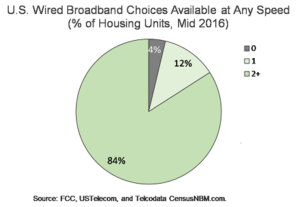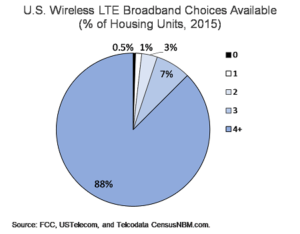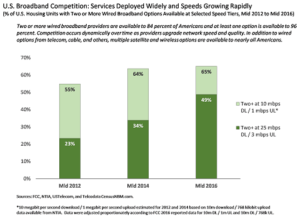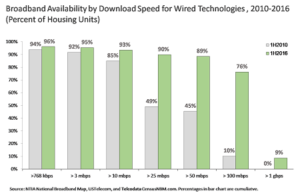August 28, 2017
More Americans have choices between broadband service providers at faster speeds than four years ago, according to a new USTelecom / CensusNBM analysis of the most current Federal Communications Commission broadband deployment data. Nearly half of U.S. households now have access to download speeds of 25 Mbps from two or more wired broadband providers and at 10 Mbps, that figure jumps to 65 percent of households, according to the report.
The analysis of government data shows that U.S. broadband providers continue to deploy and upgrade networks rapidly, bringing consumers across the nation ever-faster service and competitive options.
Broadband service in the U.S. has become more competitive over time, with multiple providers offering customers faster download speeds across a larger portion of the U.S.
One measure of competition is the availability of wired broadband at any speed, since it reflects the presence of local broadband facilities which can be upgraded by providers to offer better, faster service. As of mid-2016, 96 percent of Americans had access to wired broadband at any speed and 84 percent of Americans could choose from two or more wired providers. (See Chart 1.)
Chart 1

By the end of 2015, 99.8 percent of Americans also had a mobile broadband service available to them at any speed.
Chart 2

Availability of wired broadband at downloads speeds of 25 Mbps from two or more providers increased from 2012 to 2016 from 23 percent to 49 percent of households. Availability of wired broadband at download speeds of 10 Mbps from two or more providers grew from 55 percent of homes in mid-2012 to 65 percent of homes in mid-2016. (See Chart 3.)*
In 2010, providers had just begun to deploy fourth generation (4G) mobile broadband at advertised speeds of greater than 10 Mbps. By 2015, providers had deployed 4G mobile broadband to 99.5 percent of Americans and 95 percent of households could choose among three or more providers. (See Chart 2.) If you include technologies such as available fixed wireless and satellite technologies, the analysis improves even further.
Thanks to increased competition for customers among broadband providers, the FCC data shows that competitive deployment at higher speeds has been increasing rapidly.
Chart 3

Providers have also rolled out faster services. Availability of broadband at download speeds of 25 Mbps from at least one provider grew from 49 percent in 2010 to 90 percent in 2016 while broadband at 50 Mbps downloads showed similar growth. Availability of broadband at 100 Mbps downloads grew from 10 percent in 2010 to 76 percent in 2016. Gigabit broadband — which did not exist in 2010 as a practical matter — was available to 9 percent of households in mid-2016 and continues to grow.
Chart 4

*These speeds were used because the FCC has two definitions of broadband: 25 Mbps downloads in urban and suburban areas and 10 Mbps in rural areas which are eligible for high-cost Universal Service Fund support.